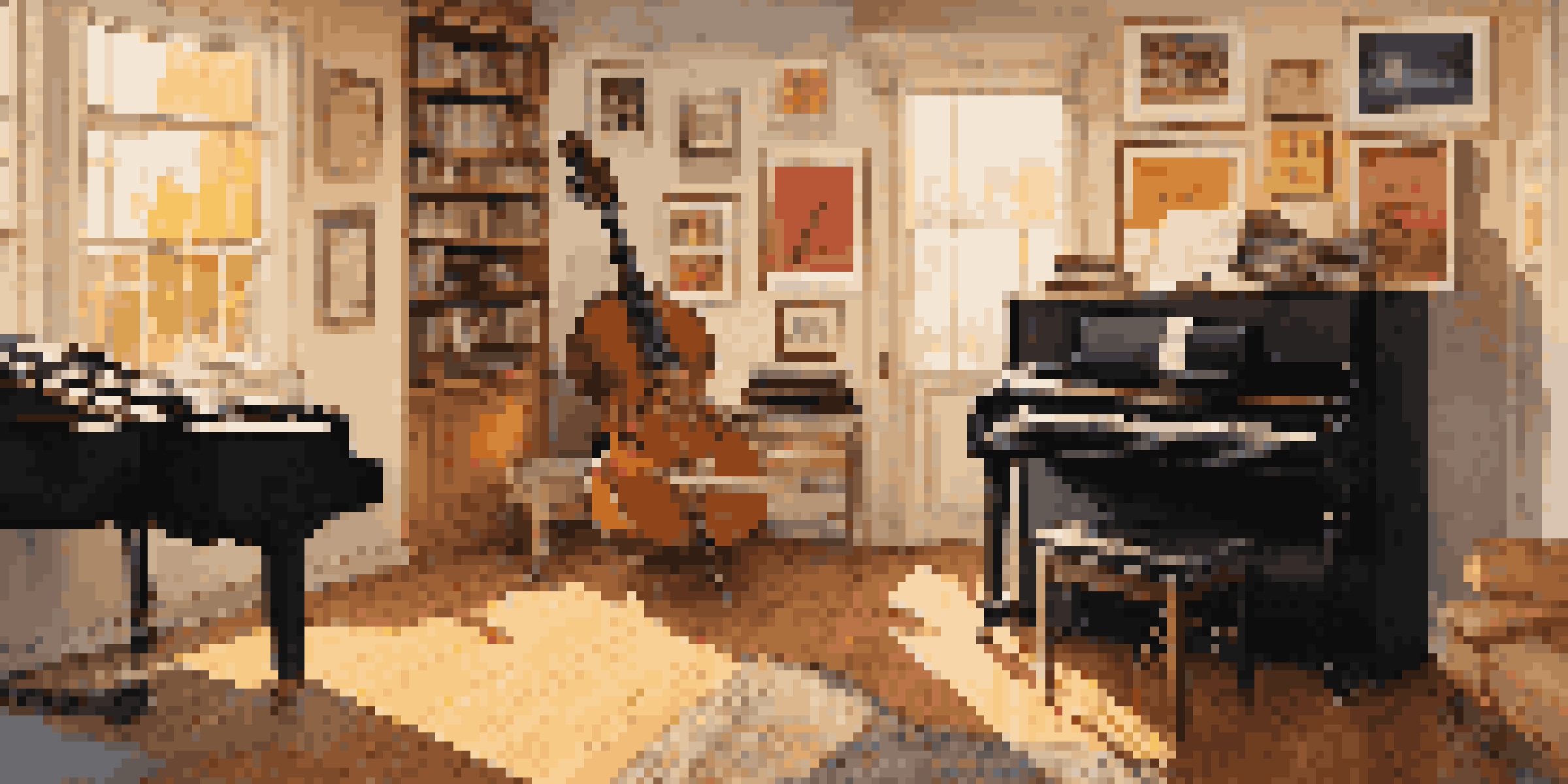Analyzing Music Form: A Guide to Common Structural Patterns

What is Music Form and Why It Matters
Music form refers to the overall structure or plan of a piece of music. It's important because it helps us understand how music is organized, making it easier to follow and appreciate. Just like a story has a beginning, middle, and end, music also has sections that convey different ideas and emotions.
Music can change the world because it can change people.
When we analyze music form, we can identify patterns that composers use to create variety and cohesion. For instance, recognizing whether a piece follows a verse-chorus format can enhance our appreciation of the songwriting craft. This understanding not only deepens our listening experience but also informs our own musical creations.
Moreover, being aware of music forms allows musicians to communicate effectively. Whether you're collaborating with others or performing, understanding the structure helps ensure everyone is on the same page. In essence, knowing about music form enriches both our appreciation and our participation in music.
The Verse-Chorus Structure Explained
One of the most common forms in popular music is the verse-chorus structure. In this format, the verse introduces the song's narrative or theme, while the chorus delivers the catchy, memorable hook. This combination creates a balance between storytelling and musicality, making it appealing to listeners.

Think of it like a conversation: the verses provide context, while the chorus highlights the main point. Songs like 'Shape of You' by Ed Sheeran exemplify this structure, with verses that set up the scene and a chorus that captures the essence of the song. This repetition of the chorus helps reinforce the message and makes it stick in the listener's mind.
Music Form Enhances Appreciation
Understanding music form allows listeners to connect more deeply with the emotions conveyed in compositions.
Understanding the verse-chorus pattern allows songwriters to create engaging music. By alternating between these sections, they can build tension and excitement, making the song more dynamic. This structure is not just for pop; it can be found in various genres, proving its versatility and effectiveness.
The AABA Form: A Classic Approach
The AABA form is a classic structure often found in jazz and traditional pop music. In this format, the 'A' sections present a main theme, while the 'B' section offers a contrasting idea or mood. This contrast keeps listeners engaged, as they anticipate the return of familiar material.
Without music, life would be a mistake.
A prime example of this form is the timeless standard 'Somewhere Over the Rainbow.' The A sections establish a dreamy, hopeful atmosphere, while the B section introduces a more reflective, contrasting moment. This interplay between familiarity and contrast creates a powerful emotional journey for the listener.
By analyzing the AABA structure, musicians can learn how to create balance in their compositions. This form encourages exploration while maintaining a sense of unity. Embracing this pattern can elevate a song, making it memorable and emotionally resonant.
Understanding the 12-Bar Blues Format
The 12-bar blues is a foundational structure in blues music, characterized by its repetitive progression. This format typically consists of three line phrases, with the first two lines stating a problem and the third offering a resolution. This structure creates a conversational feel, inviting listeners into the narrative.
Many classic blues songs, like 'Sweet Home Chicago,' follow this 12-bar structure, making it instantly recognizable. The repetition of this pattern allows musicians to showcase their improvisational skills, which is a hallmark of the blues genre. Each musician can add their unique flair while still adhering to the established format.
Verse-Chorus Structure in Songs
The verse-chorus format balances storytelling with musicality, creating engaging and memorable songs.
Understanding the 12-bar blues lays the groundwork for exploring other genres, such as rock and jazz. This flexibility demonstrates how a simple structure can lead to diverse expressions of emotion and storytelling. Musicians can draw inspiration from this form to create their own captivating narratives.
Exploring Sonata Form in Classical Music
Sonata form is a complex structure commonly used in classical music, often featuring three main sections: exposition, development, and recapitulation. This form allows composers to explore themes and motifs in depth, creating a rich tapestry of musical ideas. It's like a musical conversation that evolves over time.
In the exposition, themes are introduced, setting the stage for what's to come. The development section then takes these themes and transforms them, creating tension and intrigue. Finally, the recapitulation brings back the original themes, offering a sense of resolution and unity, much like returning home after a journey.
By analyzing sonata form, musicians gain insights into the intricacies of composition. This structure not only showcases a composer’s creativity but also engages listeners on a deeper level. Exploring sonata form can inspire contemporary musicians to incorporate classical techniques into their own works.
The Role of Call and Response in Music Structure
Call and response is a musical form rooted in African musical traditions, where one voice or instrument makes a statement (the call), and another responds. This structure creates a dynamic interaction between performers and can be found in various genres, including gospel, blues, and hip-hop. It's a powerful way to engage audiences and foster participation.
Consider how call and response works in a live setting; the energy builds as the audience joins in, creating a communal experience. Songs like 'Shout' exemplify this format, encouraging listeners to respond with their voices and movements. This interaction not only enhances the music but also strengthens the connection between performer and audience.
Call and Response Engages Audiences
This dynamic interaction fosters participation and strengthens the connection between performers and listeners.
Understanding call and response allows musicians to create engaging performances. By incorporating this structure, they can invite their audience into the musical conversation, making the experience more memorable. This form highlights the importance of community and interaction in music.
Riff-Based Structures in Modern Music
Riff-based structures are prevalent in modern music, especially in rock and funk genres. A riff is a repeated musical phrase that serves as the foundation of a song, providing a catchy hook that draws listeners in. This approach emphasizes rhythm and melody, making the music instantly recognizable.
Take 'Smoke on the Water' by Deep Purple; its iconic guitar riff is the centerpiece of the song. The rest of the music builds around this hook, creating a cohesive sound that’s both simple and profound. This structure showcases how a single musical idea can drive an entire composition.

By analyzing riff-based structures, musicians can learn how to create memorable hooks. This approach encourages creativity and improvisation while maintaining a strong sense of direction. Embracing this format can lead to the creation of music that resonates with audiences long after the first listen.
Conclusion: The Importance of Analyzing Music Form
Analyzing music form enhances our understanding and appreciation of music across genres. By recognizing common structural patterns, we can decode the intentions behind a composition and connect more deeply with the emotions it conveys. This exploration opens doors to creativity, inspiring both musicians and listeners alike.
As we’ve seen, the world of music is rich with diverse forms, each offering unique opportunities for expression. From the catchy verse-chorus structure to the intricate sonata form, these patterns shape our musical experiences. Embracing these structures can lead to more meaningful creations and performances.
Ultimately, understanding music form is a journey that enriches our relationship with music. Whether you're a musician looking to refine your skills or a listener seeking to deepen your experience, analyzing these patterns can unlock new dimensions of appreciation and creativity in the world of music.